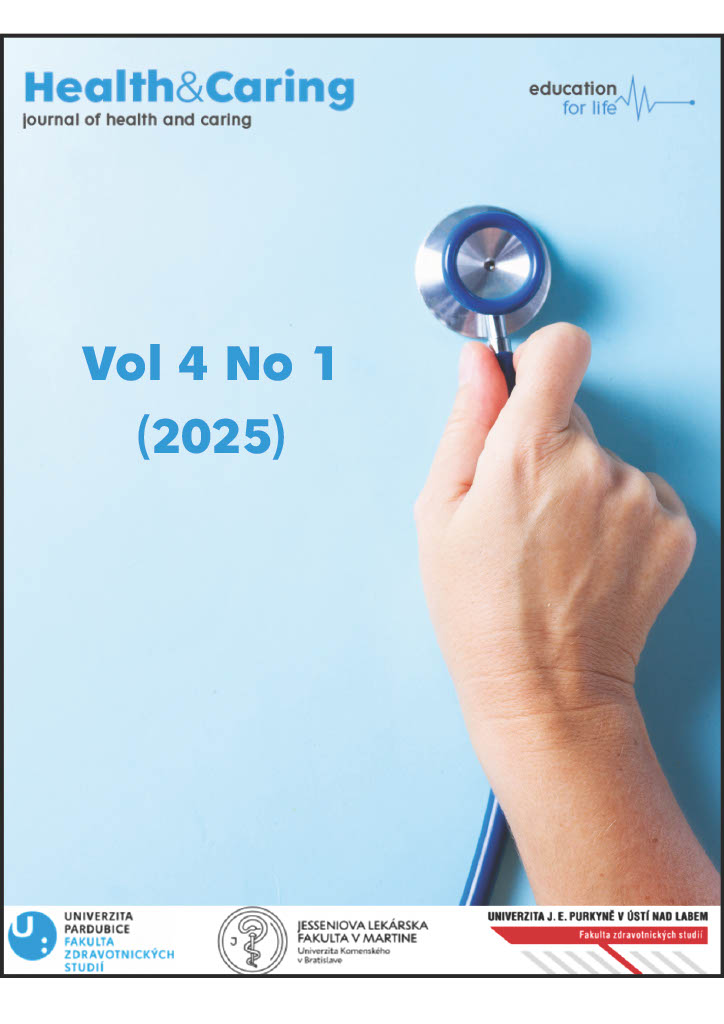Microbial Colonization of the Bladder of Patients with Urinary Catheter in Neurological Intensive Care Unit in the Context of Management of Quality: Retrospective Descriptive Study
DOI:
https://doi.org/10.46585/hc.2025.1.2641Keywords:
antibiotická rezistence; infekce spojené se zdravotní péčí; infekce vznikající v souvislosti se zavedeným permanentním močovým katétrem; kultivační vyšetření moči; management kvalityAbstract
Introduction: Health care quality management includes many aspects, including minimizing the risk of harm to a patient. One of the significant indicators of quality is the presence of infections associated with health care, including urinary tract infections associated with catheter-associated urinary tract infections (CAUTI). They’re diagnosed based on specific criteria, including lab-confirmed quantitative bacteriuria and the presence of clinical symptoms. CAUTI is an issue in the ICU (intensive care unit), especially in patients with a neurological diseases and reduced mobility. Aim: The aim of this study is to describe the nature of microbial colonies in the bladder in patients with CAUTI in the first four days of hospitalization in neurointensive care and describe the development of CAUTI. Methods: It is a retrospective quantitative data analysis, with data collected from the patient documents of those with a catheter. The urine culture examination was done in 223 patients with a catheter (51.1% women, 48.9% men) between the ages 28 and 90. Result and Conclusion: The bladder microbial colonization was laboratory confirmed as higher in the second round of collection, especially in women. Quantitave bacteriuria was laboratory confirmed in half the samples. The clinical symptom analysis confirmed CAUTI in more than 13% of the 223 patients. We recommend that regular checks of the bladder microbial colonisations continue, and that infection prevention and control, and health care quality and safety evaluation is used.
Downloads
References
Agency for Healthcare Research and Quality (AHRQ) (2015). Toolkit for Reducing Catheter-Associated Urinary Tract Infections in Hospital Units: Implementation Guide. Agency for Healthcare Research and Quality, Rockville. https://www.ahrq.gov/hai/cauti-tools/guides/implguide-pt4.html.
Česko (2011). Zákon č. 372/2011 Sb. o zdravotních službách a podmínkách jejich poskytování (zákon o zdravotních službách). In: Sbírka zákonů České republiky, 2011.
Horáčková, K. et. al. (2018). Prevence infekcí ve vztahu k ošetřovatelské péči. Univerzita Pardubice.
Jirouš, J. (2012). Prevence infekcí močových cest spojených s katetrizací. Česká společnost nemocniční epidemiologie a hygieny: Oddělení epidemiologie FN Plzeň. https://www.sneh.cz/_soubory/_clanky/30.pdf
Kollerup, I. et al. (2022). Use and quality of point-of-care microscopy, urine culture and susceptibility testing for urinalysis in general practice. Scand J Prim Health Care, 40(1), 310. https://www.tandfonline.com/doi/full/10.1080/02813432.2021.2022349.
Köves, B. et al. (2014). Řešení infekcí močových cest souvisejících s katetrizací (založené na důkazech). Urol. List. 12 (3), 912. https://www.prolekare.cz/casopisy/urologicke-listy/2014-3/reseni-infekci-mocovych-cest-souvisejicich-s-katetrizaci-zalozene-na-dukazech-50404
Kranz, J. et al. (2020). Catheter-Associated Urinary Tract Infections in Adult Patients. Dtsch Arztebl Int. 117(6) 8388. https://pubmed.ncbi.nlm.nih.gov/32102727/
Lehnertová, J. (2019). Cévkování pacientů a péče sestry o pacienty s katetrizací močového měchýře se zaměřením na prevenci vzniku infekce. Urol. Praxi, 20(5), 245249. https://www.solen.cz/pdfs/uro/2019/05/10.pdf.
Letica-Kriegel, S. A. et al. (2019). Identifying the risk factors for catheter-associated urinary tract infections: a large cross-sectional study of six hospitals. BMJ Open, 21;9(2). https://bmjopen.bmj.com/content/9/2/e022137
Lo, E. et al. (2014). Strategies to prevent catheter-associated urinary tract infections in acute care hospitals: 2014 update. Infect Control Hosp Epidemiol, (35), 3247. https://pubmed.ncbi.nlm.nih.gov/25376068/.
Ministerstvo zdravotnictví České republiky. (2013). Metodický návod – program prevence a kontroly infekcí ve zdravotnických zařízeních poskytovatelů akutní lůžkové péče. Věstník č. 2/2013. https://mzd.gov.cz/vestnik/vestnik-c-2-2013/.
National Healthcare Safety Network (NHSN). (2025). Urinary Tract Infection (Catheter-Associated Urinary Tract Infection [CAUTI] and Non-Catheter-Associated Urinary Tract Infection [UTI]) Events. Patient Safety Component Manual.
Nardullo, P. et al. (2022). Antibiotic Abuse and Antimicrobial Resistance in Hospital Environment: A Retrospective Observational Comparative Study. Medicina, 58, 1257. https://doi.org/10.3390/medicina58091257.
Paldus, V. et al. (2022). Vývoj antibiotické mikrobiální rezistence – prevalence bakteriálních kmenů v moči. Česká urologie, 26(1), 3848. https://www.czechurol.cz/pdfs/cur/2022/01/03.pdf.
Perrin, K. et al. (2021). Catheter-Associated Urinary Tract Infection (CAUTI) in the NeuroICU: Identification of Risk Factors and Time-to-CAUTI Using a Case-Control Design. Neurocrit Care, 34(1), 271278. https://pubmed.ncbi.nlm.nih.gov/32556857/.
Podrazilová, P. (2016). Minimalizace rizika vzniku infekcí spojených se zdravotní péčí u permanentního močového katétru pomocí rozhodovacího procesu. Urologie pro praxi, 17(1), 4044. https://www.urologiepropraxi.cz/pdfs/uro/2016/01/12.pdf.
Saleem, Z. et al. (2019). Point prevalence surveys of health-care-associated infections: a systematic review. Pathog Glob Health, 113(4), 191205. https://pubmed.ncbi.nlm.nih.gov/31215326/.
Sherwood, G. & Barnsteiner J. ed. (2017). Quality and Safety in Nursing: A Competency Approach to Improving Outcomes. Hoboken: John Wiley & Sons.
Sikora, A. & Zahra F. (2022). Nosocomial Infections. StatPearls. Treasure Island: StatPearls Publishing.
https://www.ncbi.nlm.nih.gov/books/NBK559312/.
Suetens, C. et al. (2018). Healthcare-Associated Infections Prevalence Study Group. Prevalence of healthcare-associated infections, estimated incidence and composite antimicrobial resistance index in acute care hospitals and long-term care facilities: results from two European point prevalence surveys, 2016 to 2017. Euro Surveill, 23(46). https://doi.org/10.2807/1560-7917.ES.2018.23.46.1800516.
Svobodová A. (2018) Catheter-associated urinary tract infections (CAUTI) – new trends and options. Hygiena, 63(2), 6667. https://hygiena.szu.cz/artkey/hyg-201802-0016_s-katetrem-asociovana-infekce-mocovych-cest-8211-nove-trendy-a-moznosti.php.
Šámal, V., Krhut, J., Zachoval R., Matoušková, M., & Broďák M. (2022). Permanentní močový katétr – dobrý sluha, zlý pán: Doporučení pro prevenci, diagnostiku a léčbu močových infekci spojených s katetrizací. Časopis lékařů českých; 161, 303308. https://www.prolekare.cz/casopisy/casopis-lekaru-ceskych/2022-7-8-1/permanentni-mocovy-katetr-dobry-sluha-zly-pan-doporuceni-pro-prevenci-diagnostiku-a-lecbu-mocovych-infekci-spojenych-s-katetrizaci-133471/download?hl=cs
von Elm E, Altman DG, Egger M, Pocock SJ, Gøtzsche PC, Vandenbroucke JP. (2008). STROBE Initiative. The Strengthening the Reporting of Observational Studies in Epidemiology (STROBE) statement: guidelines for reporting observational studies. J Clin Epidemiol, 61(4):3449. doi: 10.1016/j.jclinepi.2007.11.008. PMID: 18313558.
Downloads
Published
How to Cite
Issue
Section
License
Copyright (c) 2025 Zuzana Červenková, Patrik Zelinka, Michaela Šancová

This work is licensed under a Creative Commons Attribution-NonCommercial 4.0 International License.
Accepted 2025-06-11
Published 2025-06-18










